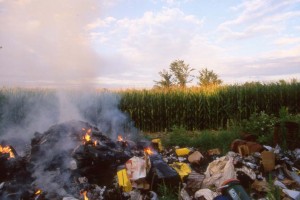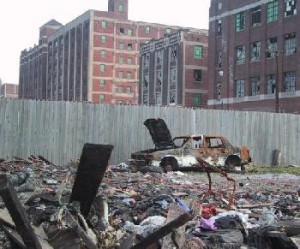Without a doubt, sanitation and the disposal of various wastes and garbage materials will be of critical importance in any post-SHTF situation. Where waste and filth accrue, bacteria, viruses and pests like mice, rats and fleas all start to thrive. In turn, a toxic and increasingly deadly environment is created and diseases start to spread.
So whether you live in an urban, suburban or more rural location, the disposal of waste materials is an important consideration.
Organic materials, including plant materials and food waste, can be turned into compost for fertilizing the soil, while animal manure can also be used as fertilizer. Human urine can even be added on top of your compost pile to aid in the decomposition process.
In addition to a compost pile for all organic wastes, a pig can further minimize the waste or loss of any food material, though there is unlikely to be any substantial amount of food waste after a serious calamity.
Burning Waste

Unfortunately, burning more toxic materials such as plastics, oils, industrial chemicals, and so on is not such a good idea, nor is it always possible.
Also unfortunately, burning just about anything runs the risk of drawing attention to yourself. A burn pile of any substantial size can give away your location, potentially for miles around. And, if you’re burning trash in an area where a lot of other people are also burning waste, everyone may end up paying the price with polluted, toxic air.
Burying Waste
If you have the space, burying solid wastes that you cannot otherwise dispose of may be an option. You’d still want to be careful about what you buried, especially in terms of harmful liquids or potent chemicals, but burial is a viable option for many solid wastes. Burial is also the option of choice for disposing of human waste, as in the case of an outhouse or latrine. Unless you have a septic system that you’re able to maintain, you’ll likely need an outhouse.
Recycling Waste
Another thing to consider is that in a post-SHTF scenario you probably won’t be throwing out nearly as much as you imagine. Aside from some various packaging materials from whatever preps you already have, such as food, barter items, etc., you’re unlikely to have much trash.
Metal and glassware can be sanitized and reused, or melted and used for new materials. Even if you can’t melt and recast such materials yourself, it’s quite likely that someone within the community will be able to and that such materials will be tradable and have some value.
Urban Wasteland

Depending on how people choose to act, the streets are likely to be contaminated with trash, refuse and sewage. In other words, it will be hugely unsanitary. Your best bet will be to maintain a sanitary perimeter around your property, or home, to the best of your ability.
If water is available, wash your hands, dishes, clothes and other tools regularly. Bury, burn or compost your waste as much as possible, or dispose of it at a location distant from your property. Keep vermin, pests and bugs away from your property by minimizing open piles of trash or refuse, and keep your food supplies well-guarded against such pests or other intruders.
Protection from Sewer Overflow
When the sewers get backed up and stop functioning, you might be surprised to find contaminated sewer waste flowing up through your shower and bath drains, through your toilets and even through your sinks.
You can protect your home from this sort of contamination by having a sewer non-return valve installed on your sewer line. A sewer non-return valve is also highly recommended for anyone who lives in a flood-prone area.
Disposing of the Dead
This is not a nice topic to cover, but considering that we’re discussing a serious post-SHTF type of scenario, it seems prudent to mention how to handle the dead in such a situation. Hopefully you’ll never actually have to dispose of a dead body, or bodies, but the likelihood exists following a serious disaster or collapse of society. In the event of societal breakdown or collapse, the number of dead can be expected to steadily increase for a while as people die of starvation, dehydration, and both chronic and acute diseases.
Bodies are typically buried or burned, with burning probably being the more likely prospect in a post-SHTF situation. Dead bodies produce an untenable stench if they are left in the open, and they swiftly attract scavengers, vermin and disease.
While it may sound somewhat callous to suggest burning bodies as the most efficient means of disposal, please keep in mind that between 55% and 80% of people today are already cremated. Burial of all the dead, especially individual burial, is simply not possible even under most modern circumstances.
Anytime you must come in contact with the bodies of the dead, exercise extreme caution. You have no way of knowing how or why a person died, nor what sort of diseases they may have had. As a result, avoid handling dead bodies unless absolutely necessary, and avoid direct contact with your skin as much as possible. Wash your hands and skin thoroughly any time you may have come into contact with a dead body.
This article has been written by Gaia Rady for Survivopedia.









Pingback:Just Measures Coin Shop » TODAY’S HEADLINES 11/12/2013 | November 12, 2013
|
Pingback:The Amazing Survival Uses of Kitchen Scraps | June 15, 2014
|
Pingback:The Amazing Survival Uses of Kitchen Scraps | TheSurvivalPlaceBlog | June 17, 2014
|
Pingback:DIY Natural Fertilizer for Your Survival Crops | SurvivoPedia | August 14, 2014
|
Pingback:How to Build an Outhouse | Survival skills, survival guns, survival guide | October 10, 2014
|
Pingback:12 Items You Should Never Repurpose Or Compost | Survival skills, survival guns, survival guide | June 30, 2015
|
Pingback:12 Items You Should Never Repurpose Or Compostdisasterdefense.usdisasterdefense.us | disasterdefense.us | June 30, 2015
|
Pingback:12 Items You Should Never Repurpose Or Compost | July 6, 2015
|
Pingback:14 Cheap Ways To Feed Your Chickens | Survivopedia | May 19, 2016
|
Pingback:14 Cheap Ways To Feed Your Chickens | Prepper's Survival Homestead | May 19, 2016
|
Pingback:14 Cheap Ways To Feed Your Chickens | | disasterdefense.us | May 19, 2016
|
Pingback:14 Cheap Ways To Feed Your Chickens | NewZSentinel | May 22, 2016
|
Pingback:Survival Gardening: How To Naturally Improve Your Soil - Prepper Dome | June 9, 2016
|
Pingback:[Recipe] The Best Pioneer Survival Food | Survivopedia | December 18, 2018
|